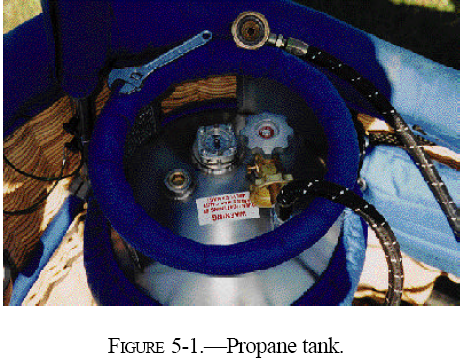|
PROPANE MANAGEMENT AND
FUELING
The primary source of heat for a hot air balloon is
propane. A pilot should be familiar with propane and
the balloon's fuel system in order to properly manage
fuel and refuel safely.
Properties of Propane
Propane is a colorless, odorless flammable gas
(C3H8) found as a by-product of natural gas and the
production of gasoline. Since pure propane has no
smell; it is odorized with a warning agent.
Liquid petroleum gas (LPG) includes propane and
butane. Propane is a gas at normal temperatures, but
will liquefy under moderate pressure. It is usually
stored in liquid form and is burned in vapor form.
The potential fire hazard for propane is similar to
that of natural gas, except that propane is heavier than
air and will sink to the ground.
The boiling point of pure propane is -44'°F. Since
vaporization is quick at normal temperatures; propane
does not present a flammable liquid hazard.
Propane is particularly suitable as fuel for hot air
balloons because it is low in weight (4.2 pounds per
gallon), high in thermal output, and its moderate tank
pressure requires no pumps to deliver it to the balloon
heater system. Propane is readily available at a
reasonable price, clean, and safe.
Propane does have some disadvantages. Propane
vapor is invisible, making it difficult to detect, and is
heavier than air, which makes it pool or gather in
low places. It is also very cold; giving freeze burns
to skin if handled incorrectly.
Balloon Propane Tanks
Propane tanks used in hot air balloons are mainly
constructed of either aluminum or stainless steel. Most
aluminum tanks are vertical 10-gallon cylinders (DOT
4E240), built primarily for forklift trucks. Stainless
steel tanks are either vertical or horizontal, of many
different sizes, and built especially for hot air
balloons. [Figure 5-1]

All balloon cylinders have liquid service valves,
excess-pressure relief valves, and liquid level
indicator valves. Many tanks have vapor service for
pilot lights and some have an emergency valve or
filler valve. Some tanks may have as many as five
individual service valves, and some have only one
combination (3-in-1) valve. There is no standard valve configuration for balloons. Generally, the large
valve handle is liquid and the smaller handle is vapor;
tanks and/or handles are usually labeled.
|

